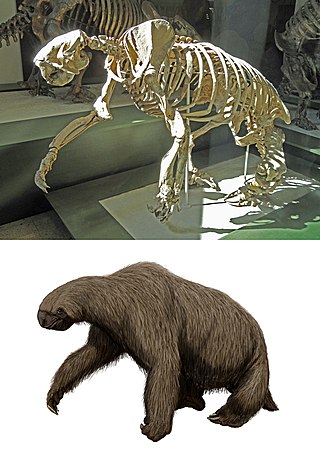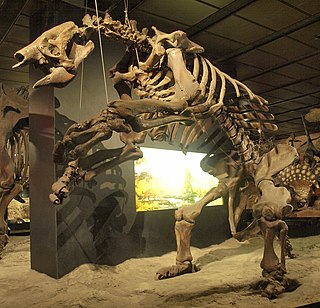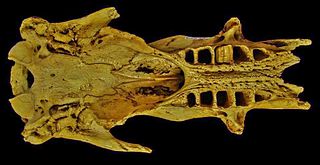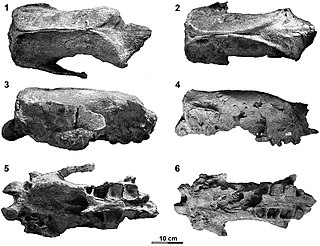
Megatherium is an extinct genus of ground sloths endemic to South America that lived from the Early Pliocene through the end of the Pleistocene. It is best known for the elephant-sized type species M. americanum, sometimes called the giant ground sloth, or the megathere, native to the Pampas through southern Bolivia during the Pleistocene. Various other smaller species belonging to the subgenus Pseudomegatherium are known from the Andes.

Megatheriidae is a family of extinct ground sloths that lived from approximately 23 mya—11,000 years ago.

Megalonychidae is an extinct family of sloths including the extinct Megalonyx. Megalonychids first appeared in the early Oligocene, about 35 million years (Ma) ago, in southern Argentina (Patagonia). There is, however, one possible find dating to the Eocene, about 40 Ma ago, on Seymour Island in Antarctica. They first reached North America by island-hopping across the Central American Seaway, about 9 million years ago, prior to formation of the Isthmus of Panama about 2.7 million years ago. Some megalonychid lineages increased in size as time passed. The first species of these were small and may have been partly tree-dwelling, whereas the Pliocene species were already approximately half the size of the huge Late Pleistocene Megalonyx jeffersonii from the last ice age.

Hapalops is an extinct genus of ground sloth from the Early to Late Miocene of Brazil, Bolivia, Colombia, and Argentina in South America.

Eremotherium is an extinct genus of giant ground sloth in the family Megatheriidae. Eremotherium lived in the southern North America, Central America, and northern South America from the Pliocene, around 5.3 million years ago, to the end of the Late Pleistocene, around 10,000 years ago. Eremotherium was widespread in tropical and subtropical lowlands and lived there in partly open and closed landscapes, while its close relative Megatherium lived in more temperate climes of South America. Both genera reached the size of today's elephants and were among the largest mammals in the Americas. Characteristic of Eremotherium was its robust physique with comparatively long limbs and front and hind feet especially for later representatives- three fingers. However, the skull is relatively gracile, the teeth are uniform and high-crowned. Like today's sloths, Eremotherium was purely herbivorous and was probably a mixed feeder that dined on leaves and grasses. Eremotherium was a generalist that could adapt its diet to the respective local and climatic conditions of many regions. Finds of Eremotherium are common and widespread, with fossils being found as far north as South Carolina in the United States and as far south as Rio Grande Do Sul, and many complete skeletons have been unearthed.

Mylodontinae is an extinct subfamily of ground sloths that lived from the Early Miocene to the Early Holocene epochs.
Mionothropus is an extinct genus of nothrotheriine nothrotheriid sloth which existed in Peru in the western Amazon Basin, during the late Miocene. It is known from the holotype LACM 4609/117533, which includes cranial remains, recovered from the riverbank deposits of the Iñapari Formation in the Río Acre region, were originally assigned to Nothropus priscus. It was first named by Gerardo De Iuliis, Timothy J. Gaudin and Matthew J. Vicars in 2011 and the type species is Mionothropus cartellei. The generic name is derived from "Mio", is a reference to the Miocene provenance of the holotype, and "nothropus" refers to the initial allocation of the holotype to this genus from the South American Pleistocene. The specific name honours Dr. Castor Cartelle.
Ahytherium is an extinct genus of megalonychid sloth that lived during the Pleistocene of what is now Brazil. It contains a single species, A. aureum.

Nothrotheriidae is a family of extinct ground sloths that lived from approximately 17.5 mya—10,000 years ago, existing for approximately 17.49 million years. Previously placed within the tribe Nothrotheriini or subfamily Nothrotheriinae within Megatheriidae, they are now usually placed in their own family, Nothrotheriidae. Nothrotheriids appeared in the Burdigalian, some 19.8 million years ago, in South America. The group includes the comparatively slightly built Nothrotheriops, which reached a length of about 2.75 metres (9.0 ft). While nothrotheriids were small compared to some of their megatheriid relatives, their claws provided an effective defense against predators, like those of larger anteaters today.

Diabolotherium is an extinct genus of megatheriine ground sloth, known from the Late Pleistocene of Peru. Unlike most other extinct mainland sloths, it seems to have been a climber, similar to extinct sloths from the Caribbean. Fossils of the genus were found at the coastal Piedra Escrita site and the Andean Casa del Diablo cave.

Megatheriinae is a subfamily of the Megatheriidae, an extinct family of ground sloths that lived from the Middle Miocene to the Early Holocene.
Megathericulus is an extinct genus of ground sloths in the Megatheriidae family. It lived during the Middle Miocene, 11-16 Ma in what is now South America. Fossils have been found principally in Argentina, Bolivia, and Peru. It is a smaller representative of the megatheres. Despite being one of the earliest-known members of the family, its dentition structure is associated with homodont teeth belonging to the more modern line of evolution. The genus was scientifically named in 1904. Only one species is currently recognized, Megathericulus patagonicus.

Proeremotherium is an extinct genus of megatheriine ground sloths in the family Megatheriidae. It lived during the Late Miocene and Early Pliocene of what is now Venezuela. So far, two largely complete skulls have been recovered in the Falcón Basin in Venezuela. The finds identify the animals as medium-sized representatives of the Megatheriidae. In the cranial anatomy, Proeremotherium resembles the later and giant Eremotherium. It is therefore assumed that the two ground sloths are directly related to each other.
Mcdonaldocnus is an extinct genus of nothrotheriid ground sloths that lived during the Middle Miocene and Early Pliocene of what is now Bolivia and Argentina. It was originally placed in the genus Xyophorus but was subsequently recognized as a distinct genus by Gaudin and colleagues in 2022. The authors reassigned the material of "Xyophorus" bondesioi, Xyophorusvillarroeli and Xyophorus sp. to Mcdonaldocnus. Fossils of Mcdonaldocnus have been found in the Cerro Azul Formation of Argentina.
Urumacotherium is an extinct genus of ground sloths of the family Mylodontidae. It lived from the Middle Miocene to the Early Pliocene of what is now Brazil, Peru and Venezuela.
Simomylodon is an extinct genus of ground sloths from the family Mylodontidae. It lived from the Late Miocene to the Middle Pliocene of what is now Bolivia and Argentina, 5.3 to 2.8 million years ago. The most important find material comes from the central Altiplano in Bolivia and includes several skulls and dentition remains. Thus, the so far documented body skeleton is the best known and most significant of a Miocene representative of the Mylodontidae. On the basis of the remains, it can be concluded that it is a rather small member of the Mylodontidae. The construction of the limbs supports ground-dwelling locomotion, but this does not exclude occasional digging or climbing. The type and only known species is Simomylodon uccasamamensis.
Aymaratherium is an extinct genus of nothrotheriid ground sloths that lived during the Late Miocene and Early Pliocene of Bolivia. Fossils of Aymaratherium have been found in the Pomata Ayte locality of the Umala Formation.
Mesopotamocnus is an extinct genus of megalonychid ground sloth that lived during the Late Miocene in what is now Argentina. Fossils have been found in the Ituzaingó Formation of Argentina.
Bolivartherium is an extinct genus of mylodontine mylodontid sloth that lived during the Late Miocene and Late Pliocene in what is now Venezuela. Fossils have been found in the Codore and Urumaco Formations of Venezuela.

Ortotherium is a genus of megalonychid ground sloth from the Late Miocene Ituzaingó Formation of Entre Rios Province, Argentina. Although many species were described, the only valid species of the genus is Ortotherium laticurvatum, with many species being junior synonyms. Ortotherium is known from very fragmentary material, all of which is material from the mandible and teeth. The holotype of O. laticurvatum consists of an incomplete left dentary that had been unearthed from a series of sediments known as ‘Conglomerado osifero’ in Paraná, Argentina. Argentina paleontologist Florentino Ameghino named the species in 1885, though he would go on to name four more, invalid, species of the genus. One species however, O. brevirostrum, has been reclassified as Mesopotamocnus.











